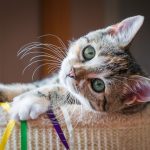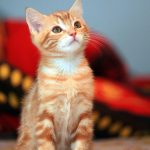Obesity is a prevalent health concern for indoor cats worldwide. These feline friends, without the need to hunt for food, can easily gain excess weight. This guide aims to provide you with a vet-approved feeding chart and tips to help control your cat’s weight effectively.
Feeding Chart for Adult Intact Indoor Cats (by Weight)
| Weight (lbs) | Average Daily Calories | Approx. Dry Food (cups) | Approx. Wet Food (3 oz cans) |
| 5 | 150 | ⅓ | 2 |
| 10 | 260 | Slightly > ½ | 3 ½ |
| 15 | 350 | ¾ | 5 |
| 20 | 440 | Slightly < 1 | 6 |
Note: This table provides approximate daily amounts of dry or wet food for cats of different weights.
Calculating Your Cat’s Needs
- An adult cat requires around 25 calories per pound of body weight. Factors like age, sex, activity level, and reproductive state can alter this. You can use a calorie calculator to determine your cat’s specific needs.
- A cup of dry food typically contains about 500 calories. For example, a ten-pound cat may need slightly more than ½ cup of dry food per day.
Wet vs. Dry Food vs. Both
- Wet food is less calorie-dense due to its higher water content. If feeding a combination, measure portions carefully to meet calorie requirements.
- A 3-oz can of wet food provides about 70-78 calories. For instance, a ten-pound cat may need approximately 3 ½ cans of wet food daily.
Considering Body Type and Exercise Level
- Giant breeds like Maine Coons may have higher healthy body weights, requiring more food.
- Active cats need more food compared to sedentary ones. Observe your cat’s playfulness and adjust portions accordingly.
Addressing Weight Issues
- If your cat is already overweight, transitioning to a controlled diet is essential. Be patient, as your cat may resist initially. Avoid free-feeding and establish set mealtimes.
- It’s crucial for cats to lose weight gradually to prevent conditions like hepatic lipidosis. Consult your vet for a safe weight loss plan.
Encouraging Exercise
- Encourage exercise by hiding small portions of food around the house or using feeding toys. These simulate hunting and help burn calories.
- Playtime with your cat, using toys like chasers or laser pointers, is an excellent way to keep them active and engaged.
In conclusion, maintaining a healthy weight for your cat is crucial for their well-being. While occasional treats are fine, ensuring they receive the right nutrition is essential. If you have concerns about your cat’s weight or appetite, consult your veterinarian for personalized advice and a tailored meal plan.



